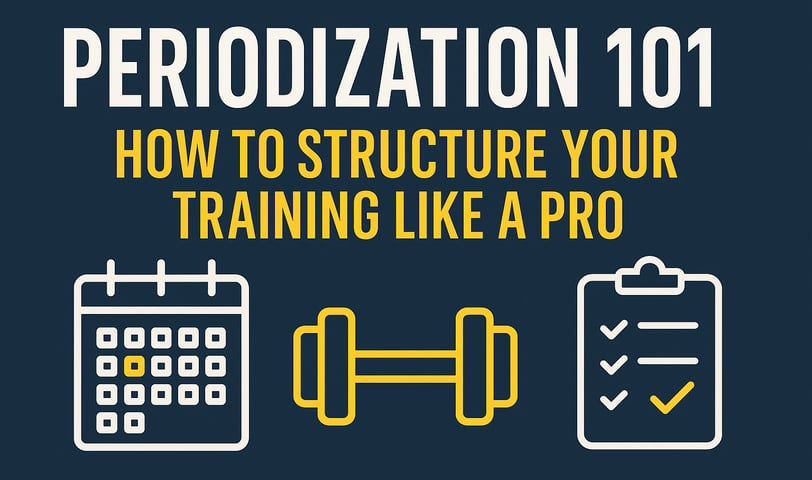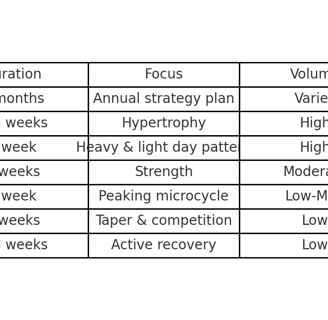Periodization 101: How to Structure Your Training for Long-Term Gains
Learn how to train like a pro using periodization. This guide breaks down macro, meso, and micro cycles to help you balance intensity, volume, and recovery for consistent performance and progress. Perfect for athletes, lifters, and coaches.
5/23/20253 min read


Periodization 101: How to Structure Your Training Like a Pro
Periodization is the strategic structuring of your training to maximize long-term gains while minimizing fatigue and injury. Rather than pushing hard every day, you plan your intensity, volume, and recovery across cycles—macro, meso, and micro—to ensure continual progress and peak performance. Here’s how to break it down like a coach.
- Macrocycles: Your Big Picture Plan
A macrocycle spans months to a year—sometimes even a full Olympic cycle. This is your overall roadmap: maybe an off-season build, a competitive season, and a recovery block. It defines your major goals: mass gain, strength peaking, skill development, or tapering for a key event.
Think of it as your annual training blueprint. During the off-season you'll focus on accumulating volume and foundational strength. As events approach, the plan shifts to higher intensity and peaking. After the main event, you’ll taper and transition.
-Mesocycles: Training Blocks Within the Macrocycle
Within that macrocycle, you have mesocycles—specific training phases lasting 4–8 weeks. Each focuses on a targeted adaptation: hypertrophy, maximal strength, power conversion, peaking, or maintenance. A typical preparatory mesocycle might include 4–6 microcycles; competitive phases often use 2–4 microcycles Wikipedia.
Example blocks:
Anatomical adaptation: reinforcing joints and connective tissue
Hypertrophy: higher volume, moderate load
Max strength: lower volume, high load
Power conversion: translate strength into explosive movement
Peaking/tapering: reduce volume, maintain intensity for competition
Mesocycles allow you to sequence training logically. You build volume first, then add intensity, then taper.
- Microcycles: The Weekly Grind
Microcycles are your week-by-week plans—usually one week long. They balance effort and recovery:
Heavy days (high intensity)
Light days (active recovery or mobility)
Rest days
A microcycle’s goal is to test your body’s adaptive response. Once your body adapts (progress stalls or fatigue builds), you change variables—load, reps, exercises—to prompt further adaptation Wikipedia.
-Cycle Integration: Intensity, Volume & Recovery
Periodization revolves around three interlinked variables:
Volume: Total work (sets × reps × load)
Intensity: Load relative to maximum (e.g., % of 1RM)
Recovery: Rest days, deload weeks, and tapering
The classic flow:
Off-season: High volume, moderate intensity
Mid-season: Moderate volume, high intensity
Pre-competition: Lower volume, peak intensity
Post-competition: Deload or active rest
This ensures long-term progress—for example, staying injury-free while building strength over months, not days.
- Why Periodize?
Without structure, athletes plateau, overtrain, or peak at the wrong time. Institutions like Human Kinetics highlight how to integrate strength, endurance, and recovery into six phases to peak precisely when it matters.
Product Books for Planning Your Macro- to Microcycles
- Periodization Training for Sports (Tudor Bompa & Carlo Buzzichelli)
Why it’s gold: This is often called the "bible" of periodization. It lays out six specific training phases—anatomical adaptation, hypertrophy, max strength, conversion, maintenance, taper—all aligned within a macro/meso/micro structure Amazon.
Good for coaches, athletes in team sports, or anyone managing season peaks.
Key takeaway: Includes ready-made schedules and integrates energy systems and nutrition.
-Structuring Your Training: A Step-by-Step Guide
1. Define Your Macrocycle (Annual or Seasonal Plan)
Decide your competitive goals for the next 6–12 months. For strength athletes, map out hypertrophy → strength → peaking → deload. For endurance runners or team athletes, insert skill or tactical phases.
2. Break It Into Mesocycles
Assign 4–8 weeks per focus:
Hypertrophy: 60–80% 1RM, 8–12 reps
Strength: 85–95% 1RM, 3–5 reps
Power: 30–60% 1RM, explosive work
Taper: cut volume 40–60%, maintain intensity
Monitor progress. If strength stalls, adjust volume or insert an extra deload.
Product we recommend Theory & Methodology Deep Dive
- Periodization: Theory and Methodology of Training (Tudor Bompa & G. Gregory Haff)
Why it matters: A comprehensive theoretical framework—history, cycle structure, practical examples, and updated research on peaking and recovery Amazon.
Good for coaches, sports scientists, and athletes seeking depth.
Formats: Paperback or Kindle (5th or 6th editions)
What stands out: Covers conjugated sequencing, summated microcycles, and advanced peaking methods.
3. Structure Your Microcycles
Within each mesocycle, design weekly layouts:
3–5 training sessions/week
Plan intensity distribution (e.g., heavy lower-body Monday, lighter upper-body Wednesday)
Schedule recovery days or active recovery sessions
Include deload cycles every 3–6 weeks: reduce volume 30–50% and intensity 20–40%. It helps limit fatigue accumulation.
Product we recommend For Runners & General Athletes
-Running Periodization: Training Theories to Run Faster (Jason Karp)
Why it’s unique: Applies periodization principles specifically to runners—covering linear, reverse linear, block, undulating models, and even menstrual-cycle-aware scheduling Amazon.
Ideal for: Distance runners and coaches planning real-world running plans
Takeaway: Balances volume, intensity, and recovery unique to run training.
Putting It All Together: Sample Plan
-Monitoring & Adjusting
Track:
Performance (strength PRs, bodyweight, times)
Readiness (RPE, mood, soreness)
Recovery (sleep, energy levels)
If you're flat for multiple weeks, consider:
Adjusting volume down
Increasing rest
Using a summated or conjugated microcycle (short blocks targeting specific qualities)
Final Thoughts
Periodization isn’t just smart training—it’s essential for long-term success. Understanding your macrocycle framework, structuring mesocycles to address specific adaptations, and polishing with microcycle management ensures progress and avoids burnout. Integrate the tools above and you’ll train like an elite coach.
Want help building your own custom year-long plan? I’d be happy to help you structure your macro/meso/micro layout based on your goals.


FITNESS
Nutrition
WellnesS
info@movebetterco.com
© 2025. All rights reserved | Privacy Policy | Terms & Conditions